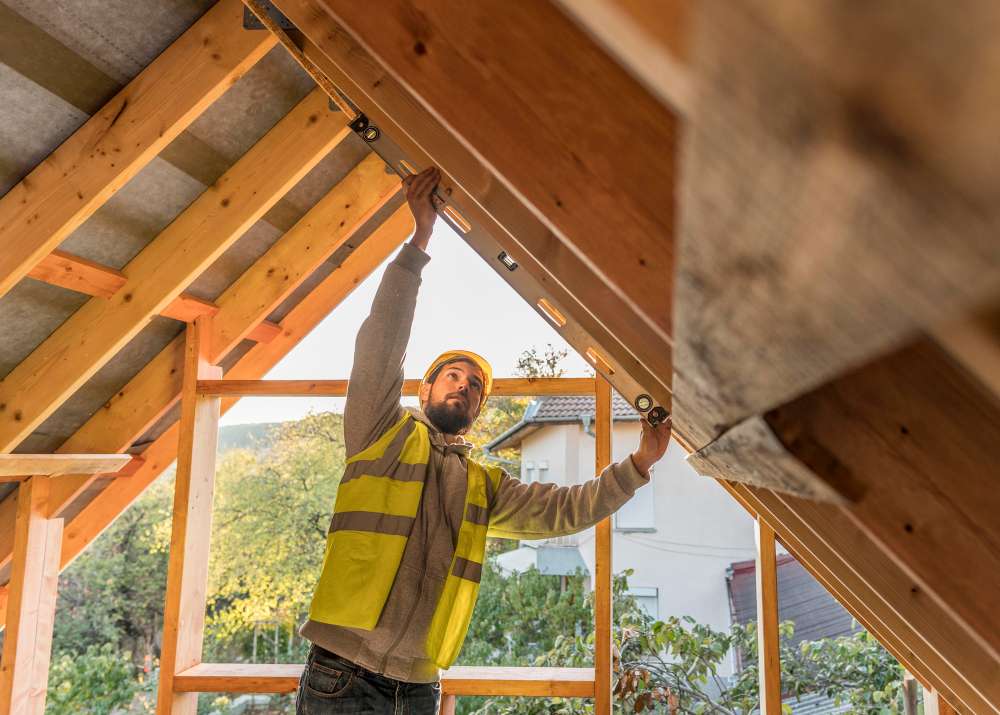Spray foam insulation is a versatile method of insulating homes, forming an expanding foam that fills gaps and creates a smooth barrier to prevent air infiltration and heat transfer. Available in open-cell and closed-cell types, it helps regulate indoor temperatures, lower energy usage, and enhance overall comfort. Its capacity to adapt to various surfaces and seal irregular shapes effectively reduces drafts.
In this blog, we will delve into how well attic spray foam insulation seals, its benefits, and how it can make you more comfortable while saving money.
What Is Attic Spray Foam Insulation and How Does It Work?
Attic spray foam insulation is a liquid material that transforms into foam when applied. Open-cell and closed-cell foam are the two primary types of spray foam insulation. Open-cells are softer and more flexible, while closed-cells are denser and provide a stronger insulating barrier. The process of application involves spraying the liquid foam onto surfaces and then allowing it to expand and fill gaps while conforming to irregular shapes.
Evaluating Suitability for Your Home
When evaluating the suitability of attic spray foam insulation for your home, consider key factors such as the current insulation, budget, and energy efficiency goals. Assessing the existing insulation condition and identifying potential gaps or issues in the attic space is crucial. If creating a more airtight and comfortable living environment aligns with your goals, this insulation could be a suitable and impactful choice for your home.
Benefits of Attic Spray Foam Insulation
Attic spray foam insulation offers a wide array of advantages that make it a compelling choice for homeowners seeking enhanced energy efficiency and comfort. Here are the benefits of this innovative insulation method in more detail:
1. Energy Efficiency
Attic spray foam insulation creates a thermal barrier, minimizing heat transfer and easing the strain on heating and cooling systems. This can result in significant energy savings in the long run, making it a cost-effective option for environmentally conscious homeowners.
2. Cost Savings
Despite the higher initial cost compared to some traditional methods, the long-term energy bill savings often make the investment in spray foam insulation worthwhile. The improved insulation helps maintain a consistent indoor temperature, minimizing the necessity for frequent thermostat adjustments.
3. Comfort Enhancement
The airtight seal created by spray foam minimizes drafts, eliminating hot or cold spots in the home. This results in a more comfortable living environment throughout the year, enhancing overall well-being for occupants.
4. Versatility
Attic spray foam insulation conforms to various surfaces and shapes, ensuring comprehensive coverage. It excels at filling gaps and hard-to-reach spaces that may need to be noticed by other insulation methods, which provides a more thorough and effective insulation solution.
5. Deterrent to Pests
The sealed barrier created by spray foam acts as a deterrent to pests, preventing insects and rodents from infiltrating the home. This not only enhances comfort but also contributes to a healthier living space by minimizing the risk of pest-related issues.
6. Durability
Resistant to common issues like mold and moisture, attic spray foam insulation offers a durable solution that can withstand the test of time. This longevity ensures continued performance, reducing the need for frequent maintenance or replacements.
7. Environmental Impact
Many spray foam formulations utilize eco-friendly materials, aligning with sustainability goals in construction practices. Choosing an environmentally conscious insulation option can contribute to a reduced carbon footprint and support overall environmental well-being.
8. Health Benefits
By creating an effective barrier against allergens and pollutants, spray foam insulation promotes better indoor air quality. This can provide notable benefits for individuals with respiratory issues or allergies, contributing to a healthier home environment.
9. Structural Support
The rigidity provided by spray foam can contribute to the structural integrity of a building. This added support may enhance the overall stability and longevity of the structure, which makes it a valuable consideration for homeowners concerned about their property’s long-term resilience.
10. Quick Installation
Compared to some traditional insulation methods, the attic spray foam insulation is efficient and can be completed relatively quickly. This minimizes disruption during installation, allowing homeowners to enjoy the benefits of improved insulation sooner.
11. Noise Reduction
Beyond its thermal insulation capabilities, spray foam provides effective sound insulation. This can be advantageous in urban or noisy environments, creating a quieter indoor space for occupants to enjoy.
12. Resale Value
Homes with well-insulated attics, especially those utilizing modern and energy-efficient methods like spray foam, often have a higher resale value. Investing in high-quality insulation can be rewarding when attracting potential buyers who prioritize energy efficiency and comfort in their home purchase decisions.
Drawbacks of Attic Spray Foam Insulation

While attic spray foam insulation offers numerous benefits, it’s important to consider potential drawbacks before deciding if it’s the right choice for your home. Here are some considerations:
- Cost
The initial expense for spray foam insulation is usually higher than traditional insulation methods. While the long-term energy savings may offset this initial investment, the immediate expense could be a concern for some homeowners.
- Installation Complexity
Proper installation of attic spray foam insulation requires expertise and specialized equipment. It’s crucial to hire a trained professional to ensure the insulation is applied correctly, which can add to the overall cost.
- Potential Health Risks During Installation
The application of spray foam involves the use of chemicals, and proper safety precautions must be taken during installation. Homeowners should be aware of possible health risks and ensure that the installation is carried out in accordance with safety guidelines.
- Off-Gassing
Some spray foam formulations may emit volatile organic compounds (VOCs) during and after installation, leading to a temporary odor known as off-gassing. While this typically dissipates over time, it can be a concern for individuals sensitive to odors or those with respiratory issues.
- Moisture Issues if Improperly Installed
If spray foam is not applied correctly or if there are pre-existing moisture issues in the attic, it can trap moisture, potentially leading to mold or other problems. Proper ventilation and addressing any existing moisture issues are crucial considerations.
- Not a Barrier to Radiant Heat
While spray foam is excellent at preventing convective heat transfer, it may not act as a barrier to radiant heat. Additional radiant barriers may be needed in conjunction with spray foam for comprehensive insulation.
- Repair Challenges
In the event of damage or the need for subsequent renovations, repairing or modifying spray foam insulation can be challenging. This can result in added complexities and costs.
Attic Spray Foam Insulation FAQs
Is spray foam insulation good for attics?
Yes, spray foam insulation is often considered highly effective for attics. It forms a seamless and airtight barrier, providing excellent thermal resistance and minimizing heat transfer. The ability of spray foam to conform to various surfaces and fill gaps makes it particularly suitable for attics, creating a well-insulated and energy-efficient space.
What are the disadvantages of spray foam roof insulation?
While spray foam roof insulation offers many advantages, it has some potential disadvantages. These include the higher upfront cost, the need for professional installation due to its complexity, possible off-gassing during application, and the challenge of repair or modification. Additionally, compatibility issues with existing insulation and the potential for moisture problems if improperly installed are considerations.
What type of foam is used for attic insulation?
Two main types of attic spray foam insulation are open-cell foam and closed-cell foam. Open-cell foam is softer and more flexible, providing effective insulation and sound absorption. Closed-cell foam is denser and offers a higher level of insulation. The choice between these depends on factors such as budget, insulation goals, and the specific requirements of the attic space.
Which insulation is best for the attic?
Determining the most suitable insulation for an attic involves considering various factors, including budget, climate, and specific requirements. The common attic insulation types are fiberglass, cellulose, and spray foam. Each has its advantages, with spray foam often being favored for its ability to create an airtight seal, preventing air leakage and providing excellent thermal resistance.
Which spray foam insulation is best in the attic?
Choosing the right spray foam for your attic comes down to open-cell and closed-cell options. Open-cell foam is soft and expands a lot, filling gaps well. It’s budget-friendly and good for sound absorption. Closed-cell foam is dense and sturdy, with less expansion. It has a higher insulation value, resists moisture, and provides structural support. The choice relies on factors like budget and the attic’s unique characteristics. Seeking advice from insulation experts can assist you in identifying the most suitable option for a specific attic.
Conclusion
Attic spray foam insulation is a practical choice for homeowners seeking improved energy efficiency and comfort. By forming a seamless barrier, it minimizes heat transfer and drafts, offering long-term benefits like cost savings and consistent indoor temperatures. Opting for open-cell or closed-cell spray foam or exploring alternative insulation types, homeowners can maximize the benefits by consulting with professionals. This ensures the best fit for their budget and attic space.
At Tropic Air Conditioning, we’re here to make your home comfortable and energy-efficient. From keeping it warm in winter to staying cool in summer, we’re committed to helping you create the perfect living space. To learn more about our services, book an appointment now.




